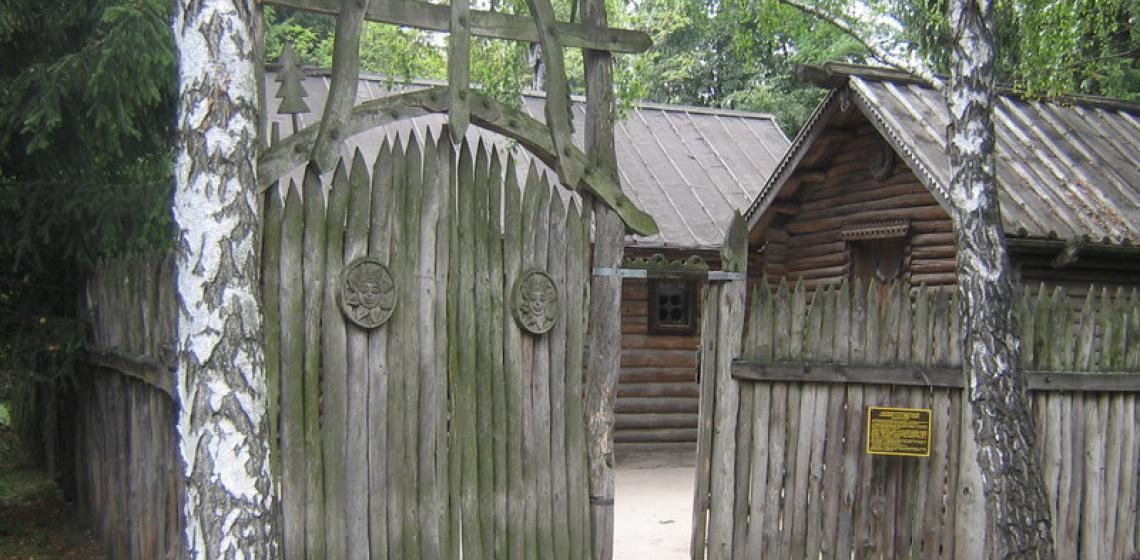
At the ethnographic open-air museum in Pereiaslav-Khmelnytskiy (near Kyiv) you can find the wooden houses and places of worship of the 17th – 19th centuries as well as reconstructed buildings of earlier eras.
On the territory there are a numerous of museums (embroidery, ceremonies, transportation, bread, space, museum-mail, etc.). The museum is set in an open-air area of 30 hectares and includes many buildings, museums, churches, and a unique atmosphere. Here you can learn about how different segments of the population lived in the Ukraine in the old days. The museum is an important cultural and educational institutions to help assess the cultural heritage of the past, reveal traces of interference of cultures and see local history of the Middle Dnieper Region.
The construction of the open-air museum was launched in 1964. The area meets the conditions under which a settlement occurred in ancient times. The museum grounds contain remains of archaeological monuments (a Bronze Age mound, the remains of a settlement and burial ground of the Chernyakhivska Culture of the 2nd – 5th centuries and more). Nearby one can find the so-called dragon rolls (defensive structures from the 3rd and 4th century).
On the 30 hectares, 185 objects are located, including 104 monuments of folk architecture of the seventeenth and nineteenth centuries, 20 yards of houses and outbuildings, 23 different settings and workshops, over 20 thousand works of folk art and implements, and household items collected in the forest-steppe zone of Ukraine. The museum is lined with tens of thousands of trees and shrubs, carefully maintained gardens and yards.
The museum also has several reconstructed dwellings from the Palaeolithic up to the Late Middle Ages. The Palaeolithic site reproduced in this museum was originally located on the left bank of the Supiy River belonging to a group of mammoth hunters from 15,000 BC. The frame of the hut is made of wooden poles, which are covered with skins of animals. The base of the hut is decorated with large mammoth bones, mainly skulls, which are inserted into the post holes. Storage pits were filled with bones and mammoth tusks. These places were used to make stone and bone tools. Next to huts one finds open fire places, around which flint tools were made.
The reconstructed Rus house from the 11th century is a single-chamber semi-dugout house sizing 3.8 x 4 meters. This residence was typical for old Pereiaslav. The walls are made of hewn pine logs in the technique of horizontal filling "in Shula." The gabled roof has a ridge and groove for water drainage. The interior is reconstructed. In the right corner a cob oven is placed. To the left, a plank bunk is made covering the grain supply. In the centre of the room an oak stump is turned into a table.
A manor from Kiev from the 10th century is built new here as well, an economic complex, created on the basis of two log cabins. The farmstead is fenced with a high palisade which includes houses and outbuildings. All structures are built of pine logs. The residence is two-chambered: chalet + canopy. The lower half of the residential logs are lying on the ground, propped up the corners of the vestibule oak risers. In the residential part, in the corner to the right of the door a cob oven is constructed. The interior exhibition uses authentic things from the 11th – 13th centuries from archaeological excavations, as well as from the ethnographic collection of the museum.
A Polovtsian sanctuary from the 12th – 13th century was reconstructed here as well. It is a rectangular area, lined with limestone recess with stone statues placed in the centre - two female and one male. The sculptures presented in the sanctuary are the most advanced and perfect type of this period. In the pit of the sanctuary one found animal bones of a horse, sheep and bull, a copper kettle and fragments of amphorae. These sanctuaries were built in honour of the patron of the ancestors.
Finally, the museum also shows a reconstruction of a 17th century Cossack outpost.
Text Source: Wikipedia
Photo: reconstructed dwelling from the 11th Century, Pereyaslav-Khmelnitsky district, Kyiv region, Жилище ХІ века, с. Сосновая, Переяслав-Хмельницкий район, Киевская область.
Аuthor: Uk-Kamelot - собственная работа, CC BY-SA 3.0, https://commons.wikimedia.org/w/index.php?curid=2682160
